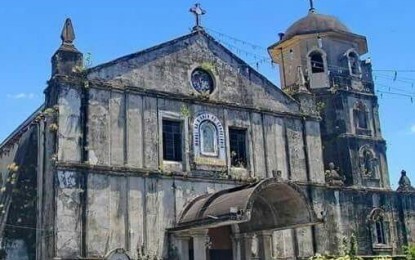
OUR LADY OF CANDELARIA PARISH - Silang, home to one of the oldest – if not the oldest - churches in the Philippines today is famous for its 300 year old altar piece and the Caviteǹos’ religious tradition of venerating Mary, as Mother of our Catholic God. (Photo courtesy of Our Lady of Candelaria Facebook page)
SILANG, Cavite -- The Nuestra Seǹora de Candelaria (Our Lady of Candelaria), more popularly known as the Silang Church and is considered as the oldest standing structure of colonial baroque architecture in Cavite, is truly an architectural and engineering marvel.
Due to its association with prehistoric events and past industries, the church complex and its retablos (altarpiece) was declared as National Cultural Treasure (NCT) by the National Museum in 2017.

As NCT, the church “will receive protection and priority on heritage management projects from the national government,” Phillip Lacson Media, chairman of the “Sumilang” Fiesta Executive Committee and member of the Silang Heritage Council, told the Philippine News Agency (PNA) on Friday.
The church’s historical significance, its authenticity, and the exquisite beauty of its woodwork, plus the harmony of its decorative features and implements with the baroque church, and the church’s retablos, catapulted it to the NCT list, Medina added.
He said the church retablos, finished in the early 17th century, are “a unique testament to Filipinos’ creativity and indomitable spirit”, highlighting the indigenous and local elements used in a supposedly colonial art.
After its declaration in 2017, the church received its NCT brass marker, which was formally unveiled to the people of Silang last February 3, in time of the town’s celebration of “Sumilang”.
A joint initiative of the Silang Parish Council for Culture and Heritage and the local government of Silang, the commemoration is the church’s third remarkable marker, adding up to the historical marker given in 2008 by the National Historical Commission of the Philippines (NHCP); and the pilgrim church marker from the Diocese of Imus given in 2012 as part of the Golden Jubilee celebration of the diocese.
Various dignitaries, led by Deputy Head of Mission of the Spanish Embassy Amaya Fuentes, and local officials, led by 5th District Rep. Roy Loyola, came in full force to witness the unveiling event.

The declaration of documents was signed by town mayor Emilia Lourdes Poblete, along with Bishop Reynaldo Evangelista and Fr. Marty Dimaranan and National Museum representative Raquel Flores, and witnessed by representatives of the government, the Spanish Embassy to the Philippines, the Intramuros Administration, and president of the Cavite Historical Society, former Prime Minister Cezar E.A. Virata.
The town was established as a parish on February 3, 1595.
The church’s dedication to the Nuestra Seǹora de Candelaria was done by the Jesuits, based on the tale told by Fray Murillo Verlarde, where the image of the Virgin Mary was found by Andres in the mountains of Silang in 1640.
Its first patron saint was San Diego Alcala, a Franciscan.
Franciscans Fray Diego de la Concepcion and Juan de la Cruz were missionaries who first propagated the seeds of Christianity in Silang, including the upland towns of Maragondon, Ternate, Indang, Alfonso, and portions of Marinduque, on February 3, 1595.
This event "is just a prelude to a much grander celebration on its 425th year in 2020," Medina added. (PNA)
